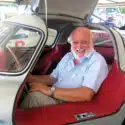The Commodore and the CTA
Air-Commodore Rodwell Banks was a considerable figure in engine development history. From 1927-31, working first for Anglo-American Oil, then the Ethyl Gasoline Corporation, he became the fuel consultant who played a crucial role in brewing the fuels which helped the Supermarine S6 and S6B seaplanes win the Schneider Trophy in perpetuity. He had much to do with introducing tetraethyl lead to petrol for its remarkable anti-knock effect and advised Fiat on boosting its ‘tandem-12’ 24-cylinder AS6 aero engine – which at 52 litres was some 15.4 larger than the Supermarines’ Rolls-Royce ‘R’-Type V12 – to reach 2850 horsepower. The Fiat engine then blasted the Macchi-Castoldi 72 seaplane to a new world record speed of 440.709mph in 1934.
Post-war, Rod Banks of Associated Ethyl resumed consultancy work with car and aero engine manufacturers worldwide. He spent a lot of time with the re-emergent French industry and around 1947 visited the Arsenal at Chatillon where a Government-backed engineering group was trying to develop new designs. He found them struggling with a large, vertical H-type design for a 24-cylinder liquid-cooled engine with twin crankshafts, geared together. It sounds like a huge H16 BRM predecessor, stood on its side. The Arsenal team told Banks the crankshafts kept breaking, but they couldn’t understand why. Examining the broken bits, he found conclusive evidence of torsional failure, due to the shafts writhing around. The French engineers then astonished him by saying they suspected the crankcase might be too rigid, so they were designing one which would be more flexible “to accommodate the crankshafts”. The Commodore had a reputation for straight talking, and he declared that a crankcase deliberately designed to give even less support would probably see the crankshafts break more quickly, if the crankcase didn’t beat them to it… Which it subsequently did.
What’s this got to do with motor sport? Well, the Arsenal was involved with CTA – the Centre d’Etudes Techniques de l’Automobile – which was attempting to produce a French national Grand Prix car to recapture the lapsed racing prestige of Bugatti and Delage. Albert Lory – whose 1926-27 straight-8 Delage had been such a masterpiece – designed a supercharged 1482cc four-cam V8 claimed to produce 266bhp at 7500rpm. It was mounted in a somewhat eccentric chassis, and the first of two cars built emerged for the 1947 Grand Prix de l’ACF at Lyons-Parilly. Raymond Sommer drove, but the car snapped a half-shaft at the start – just as the prototype V16 BRM would at Silverstone in 1950, again with Sommer operating the clutch. But the V16 had a future, the CTA-Arsenal had none, and to date has never raced again. Indeed, just this May it failed to make the grid once more, at the Monaco Historique.
Among its peculiarities was a back-to-front gearchange gate, and while as delivered to Lyons the gearlever was about 7-8 inches long – which means already too long, with a sturdy knob on top – I think Sommer must have found his left fist hitting the dash panel in the forward plane. For the race the original lever with its knob removed was then sleeved by about 18 inches of thicker tube, cranked outboard to clear the cockpit cowl. This seems to me symptomatic of a curious way to go racing, and few were surprised when this French Government project promptly evaporated. Twenty years later – with tacit Government approval – Matra Sports would do it so much more effectively…

